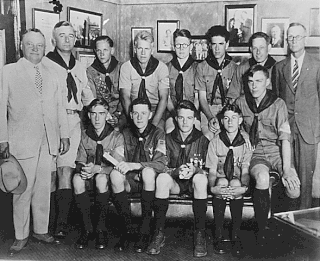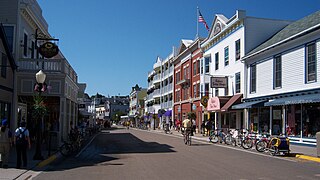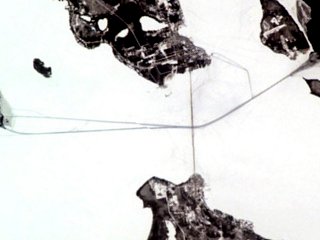
Lake Michigan is one of the five Great Lakes of North America. It is the second-largest of the Great Lakes by volume and the third-largest by surface area, after Lake Superior and Lake Huron. To the east, its basin is conjoined with that of Lake Huron through the narrow Straits of Mackinac, giving it the same surface elevation as its easterly counterpart; the two are technically a single lake.

The Mackinac Bridge is a suspension bridge spanning the Straits of Mackinac to connect the Upper and Lower peninsulas of the U.S. state of Michigan. Opened in 1957, the 26,372-foot-long bridge is the world's 24th-longest main span and the longest suspension bridge between anchorages in the Western Hemisphere. The Mackinac Bridge is part of Interstate 75 (I-75) and the Lake Michigan and Huron components of the Great Lakes Circle Tour across the straits; it is also a segment of the U.S. North Country National Scenic Trail. The bridge connects the city of St. Ignace on the north end with the village of Mackinaw City on the south.

The Upper Peninsulaof Michigan – also known as Upper Michigan or colloquially the U.P. – is the northern and more elevated of the two major landmasses that make up the U.S. state of Michigan; it is separated from the Lower Peninsula by the Straits of Mackinac. It is bounded primarily by Lake Superior to the north, separated from the Canadian province of Ontario at the east end by the St. Marys River, and flanked by Lake Huron and Lake Michigan along much of its south. Although the peninsula extends as a geographic feature into the state of Wisconsin, the state boundary follows the Montreal and Menominee rivers and a line connecting them.

Mackinac Island is an island and resort area, covering 4.35 square miles (11.3 km2) in land area, in the U.S. state of Michigan. It is located in Lake Huron, at the eastern end of the Straits of Mackinac, between the state's Upper and Lower Peninsulas. The island was long home to an Odawa settlement and previous indigenous cultures before European colonization began in the 17th century. It was a strategic center of the fur trade around the Great Lakes. Based on a former trading post, Fort Mackinac was constructed on the island by the British during the American Revolutionary War. It was the site of two battles during the War of 1812 before the northern border was settled and the US gained this island in its territory.

Mackinac County is a county in the Upper Peninsula of the U.S. state of Michigan. As of the 2010 census, the population was 11,113. The county seat is St. Ignace. Formerly known as Michilimackinac County, in 1818 it was one of the first counties of the Michigan Territory, as it had long been a center of French and British colonial fur trading, a Catholic church and Protestant mission, and associated settlement.

Emmet County is a county located in the U.S. state of Michigan. As of the 2010 census, the population was 32,694. The county seat is Petoskey.

Scouting in Michigan has a long history, from the 1910s to the present day, serving thousands of youth in programs that suit the environment in which they live.

Mackinac Island is a city in Mackinac County in the U.S. state of Michigan. In the 2010 census, the city had a permanent population of 492. The summer population numbers in the thousands due to an influx of summer visitors and hundreds of seasonal workers.

Saint Ignace, usually written as St. Ignace, is a city near the tip of the Upper Peninsula of the US state of Michigan, on the northern side of the Straits of Mackinac. It sits on the shore of Lake Huron at the north end of the Mackinac Bridge, opposite Mackinaw City, serving as the gateway to the UP for travelers coming from the Lower Peninsula. It is one of two ports with ferry service to Mackinac Island, and is the only mainland city accessible from the island when Lake Huron is frozen over. St. Ignace Township is located just to the north of the city, but is politically independent.

Mackinaw City is a village in Emmet and Cheboygan counties in the U.S. state of Michigan. The population was 806 at the 2010 census; the population surges during the summer tourist season, including an influx of tourists and seasonal workers who serve in the shops, hotels and other recreational facilities there and in the surrounding region. Mackinaw City is at the northern tip (headland) of the Michigan's Lower Peninsula along the southern shore of the Straits of Mackinac. Across the straits lies the state's Upper Peninsula. These two land masses are physically connected by the Mackinac Bridge, which runs from Mackinaw City north to St. Ignace. Mackinaw City is also the primary base for ferry service to Mackinac Island, located to the northeast in the straits.

The Straits of Mackinac are narrow waterways in the U.S. state of Michigan between Michigan's Lower and Upper Peninsulas. The main strait flows under the Mackinac Bridge and connects two of the Great Lakes, Lake Michigan and Lake Huron. The main strait is 3 1⁄2 miles wide and has a maximum depth of 295 feet. Hydrologically, the two connected lakes can be considered one lake, known as Lake Michigan–Huron. Historically, the native Odawa people called the region around the Straits Michilimackinac. The Straits of Mackinac are "whipsawed by currents unlike anywhere else in the Great Lakes".

Fort Mackinac is a former British and American military outpost garrisoned from the late 18th century to the late 19th century in the city of Mackinac Island, Michigan, on Mackinac Island. The British built the fort during the American Revolutionary War to control the strategic Straits of Mackinac between Lake Michigan and Lake Huron, and by extension the fur trade on the Great Lakes. The British did not relinquish the fort until fifteen years after American independence.
M-185 is a state trunkline highway in the U.S. state of Michigan that circles Mackinac Island, a popular tourist destination on the Lake Huron side of the Straits of Mackinac, along the island's shoreline. A narrow paved road of 8.004 miles (12.881 km), it offers scenic views of the straits that divide the Upper and the Lower peninsulas of Michigan and Lakes Huron and Michigan. It has no connection to any other Michigan state trunkline highways—as it is on an island—and is accessible only by passenger ferry. The City of Mackinac Island, which shares jurisdiction over the island with the Mackinac Island State Park Commission (MISPC), calls the highway Main Street within the built-up area on the island's southeast quadrant, and Lake Shore Road elsewhere. M-185 passes by several important sites within Mackinac Island State Park, including Fort Mackinac, Arch Rock, British Landing, and Devil's Kitchen. Lake Shore Road carries the highway next to the Lake Huron shoreline, running between the water's edge and woodlands outside the downtown area.
Michilimackinac is derived from an Ottawa Ojibwe name for present-day Mackinac Island and the region around the Straits of Mackinac between Lake Huron and Lake Michigan. Early settlers of North America applied the term to the entire region along Lakes Huron, Michigan, and Superior. Today it is considered to be mostly within the boundaries of Michigan, in the United States. Michilimackinac was the original name for present day Mackinac Island and Mackinac County.

Northern Michigan, also known as Northern Lower Michigan, is a region of the U.S. state of Michigan. A popular tourist destination, it is home to several small- to medium-sized cities, extensive state and national forests, lakes and rivers, and a large portion of Great Lakes shoreline. The region has a significant seasonal population much like other regions that depend on tourism as their main industry. Northern Lower Michigan is distinct from the more northerly Upper Peninsula and Isle Royale, which, obviously, are also located in "northern" Michigan. In the northernmost 21 counties in the Lower Peninsula of Michigan, the total population of the region is 506,658 people.

The Battle of Mackinac Island was a British victory in the War of 1812. Before the war, Fort Mackinac had been an important American trading post in the straits between Lake Michigan and Lake Huron. It was important for its influence and control over the Native American tribes in the area, which was sometimes referred to in historical documents as "Michilimackinac".

St. Helena Island is an uninhabited 240 acres (97 ha) island in the Lake Michigan approach to the Straits of Mackinac. The island is located offshore from Gros Cap, Michigan, 10 miles (16 km) west of Mackinac Island in Mackinac County in the U.S. state of Michigan.

St. Martin Island is located off the Garden Peninsula in Delta County in the U.S. state of Michigan. It is the southernmost island in Michigan that is part of a line of islands at the mouth of the bay of Green Bay and is part of the Niagara Escarpment.

East Moran Bay is a small, historic harbor in the Straits of Mackinac adjacent to the city of St. Ignace in the U.S. state of Michigan. The harbor is used as a commercial port for Star Line Ferry and Shepler's Ferry ferry boats from St. Ignace to Mackinac Island, a tourist center of the Straits of Mackinac. The bay and its harbor are guarded by the Wawatam Lighthouse.
Agatha de LaVigne Biddle (1797–1873) was a woman of Odawa and French heritage, who primarily identified with her Odawa kin. She resided on Mackinac Island during the fur trade era and after. She acted as a partner with her husband in running their fur trade business, and Biddle was known as a shrewd businesswoman and her kinship connections were an integral part of the Biddle business. She was pivotal in the negotiations of the 1855 Treaty of Detroit where she used her relationships with local Indigenous peoples and settlers to negotiate on behalf of the Odawa peoples. Biddle was also renowned for her charity, and the aid she provided to her community, including needy children. The home she shared with her husband, independent fur trader Edward Biddle, known as Biddle House, still stands on Mackinac Island and was the site of many local gatherings. Agatha Biddle will be inducted into the Michigan Women’s Hall of Fame on October 18, 2018.
















